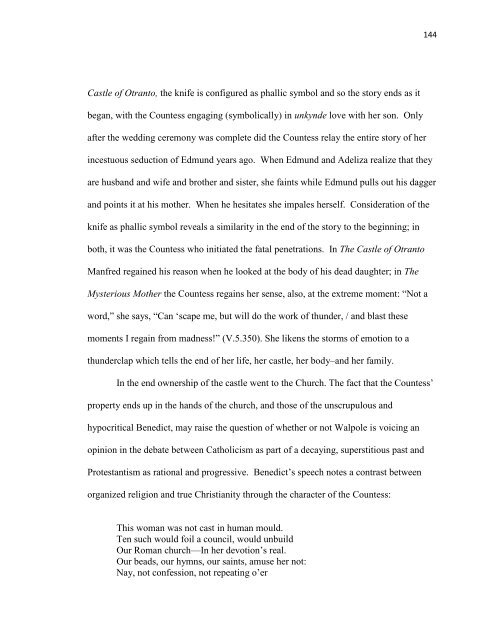SUMMERS, KAREN CRADY, Ph.D. Reading Incest - The University ...
SUMMERS, KAREN CRADY, Ph.D. Reading Incest - The University ...
SUMMERS, KAREN CRADY, Ph.D. Reading Incest - The University ...
You also want an ePaper? Increase the reach of your titles
YUMPU automatically turns print PDFs into web optimized ePapers that Google loves.
144<br />
Castle of Otranto, the knife is configured as phallic symbol and so the story ends as it<br />
began, with the Countess engaging (symbolically) in unkynde love with her son. Only<br />
after the wedding ceremony was complete did the Countess relay the entire story of her<br />
incestuous seduction of Edmund years ago. When Edmund and Adeliza realize that they<br />
are husband and wife and brother and sister, she faints while Edmund pulls out his dagger<br />
and points it at his mother. When he hesitates she impales herself. Consideration of the<br />
knife as phallic symbol reveals a similarity in the end of the story to the beginning; in<br />
both, it was the Countess who initiated the fatal penetrations. In <strong>The</strong> Castle of Otranto<br />
Manfred regained his reason when he looked at the body of his dead daughter; in <strong>The</strong><br />
Mysterious Mother the Countess regains her sense, also, at the extreme moment: “Not a<br />
word,” she says, “Can ‘scape me, but will do the work of thunder, / and blast these<br />
moments I regain from madness!” (V.5.350). She likens the storms of emotion to a<br />
thunderclap which tells the end of her life, her castle, her body–and her family.<br />
In the end ownership of the castle went to the Church. <strong>The</strong> fact that the Countess’<br />
property ends up in the hands of the church, and those of the unscrupulous and<br />
hypocritical Benedict, may raise the question of whether or not Walpole is voicing an<br />
opinion in the debate between Catholicism as part of a decaying, superstitious past and<br />
Protestantism as rational and progressive. Benedict’s speech notes a contrast between<br />
organized religion and true Christianity through the character of the Countess:<br />
This woman was not cast in human mould.<br />
Ten such would foil a council, would unbuild<br />
Our Roman church—In her devotion’s real.<br />
Our beads, our hymns, our saints, amuse her not:<br />
Nay, not confession, not repeating o’er
















